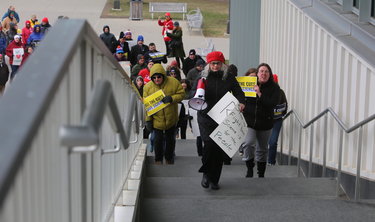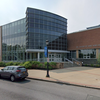‘Kill the cuts’: Protesters rally at UAlbany to ‘save science,’ jobs, lives, and democracy
The day was cold; the chants were hot:
“We build up. Trump tears down.”
“Stand up. Fight back.”
“Kill the cuts. Kill the cuts.”
About 50 protesters — union leaders, research scientists, health workers, and students — chanted as they marched through the University at Albany’s uptown campus and then picketed along Washington Avenue on April 8, a national day of action to oppose the Trump administration’s cuts to research, health care, and higher education.
“We are trying to save science,” said Fred Kowal, United University Professions president, at a rally before the march. “We’re trying to save the principle that the search for knowledge and wisdom is vital to the future of the human race. But, beyond that, this is about saving our democracy.”
Melinda Person, president of New York State United Teachers, representing about 700,000 members, said that cuts to the National Institutes of Health total about $850 million in New York state
“That is 10,000 jobs,” said Person. “These are jobs that serve our entire communities. It’s not just people that work on campuses. They support entire towns.”
She also said that NYSUT is litigating. “We are in court all the time. Just on Friday, we joined a multi-state effort to push back against these cuts and to get the funding restored,” said Person.
J. Andrew Berglund, SUNY Distinguished Professor and director of UAlbany’s RNA Institute, said the RNA Institute has 16 scientists, eight Ph.D. students, four postdoctoral fellows, and four staff members — all funded by NIH, the National Science Foundation, and the Department of Defense.
The institute studies neuromuscular diseases like ALS and muscular dystrophy. “Unfortunately, all these diseases don’t have effective treatments or cures,” said Berglund.
“I’ll have to let staff and postdoctoral fellows go,” said Berglund, noting that research will be “dramatically curtailed, which is sad because we’re making progress. There’s lots of promising things in clinical trials that we’re optimistic about.”
Berglund said that 99.4 percent of drugs approved by the Food and Drug Administration were funded by NIH. “So that means, for every dollar that NIH invests, there’s a $2.56 economic investment so there’s an amazing economic return on these dollars that we’re investing.”
UAlbany graduate student Sharon Shaughnessy, who works at the RNA Institute, said to cheers from the crowd, “I’m here in part to stand up for my friends who are international students or faculty who are being bullied out of expressing their freedom of speech.”
Shaughnessy also said, “I’m here because, as a scientist, I love truth and facts and I don’t like them being treated like they don’t matter. I’m here because I love living and working in a diverse society and that is also under threat right now.”
She urged the crowd to look up Martin Luther King’s “We Shall Overcome” speech and then went on to quote from that speech: “We can rise from the fatigue of despair to the buoyancy of hope, and this will be a great America because we will be the participants in making it so.”
Bruce Giddings, vice president of the Public Employees Federation for New York State, spoke of the harm done by cuts to a facility that treats addiction.
“These cuts not only affect the people, the staff, but also affect the communities as well,” he said, adding, “This is just the tip of the iceberg.”
Myron Getman, a research scientist with the state’s health department, said the federal cuts have already caused “permanent damage.”
He elaborated, “The COVID funding that was clawed back just recently resulted in the termination of the public health fellowship program, which was intimately associated with wastewater surveillance.”
The analysis of wastewater allows scientists to see where viruses have spread.
Getman named a list of diseases — from Lyme disease to bird flu — that will be affected as will “environmental things like PFAS or lead.”
“A fundamental responsibility of a government is to protect its people,” said Getman. “And public health deserves protection. It does not, should not, and must not be privatized.”
Michael Fitzsimmons, a member of the New York State Nurses Association who has worked in the intensive care unit at Albany Med for 27 years, said, “Any cuts to Medicare, Medicaid will be devastating for our hospitals. Albany Med is funded 70 percent by Medicare and Medicaid and they get other government monies.”
A federal worker for Social Security said, “We are the canaries in the coal mine.”
She said reductions to the Social Security staff have left offices overloaded. “People are panic filing,” she said. “Offices are running out of basic supplies like paper and envelopes.”
Sally D’Alessandro, assistant dean of students at UAlbany, said that 60 percent of the university’s students receive Pell grants.
She said of the Trump administration, “Project 2025, which they are following to the letter, maybe even faster than recommended, plans to cut all need-based aid. How are we going to work with 40 percent of our students here?” she asked.
“So,” she went on, “we are fighting for our jobs. We are fighting for our freedom. We might be fighting for our very lives.”
With that, D’Alessandro picked up her bullhorn and led the protesters on their march.



